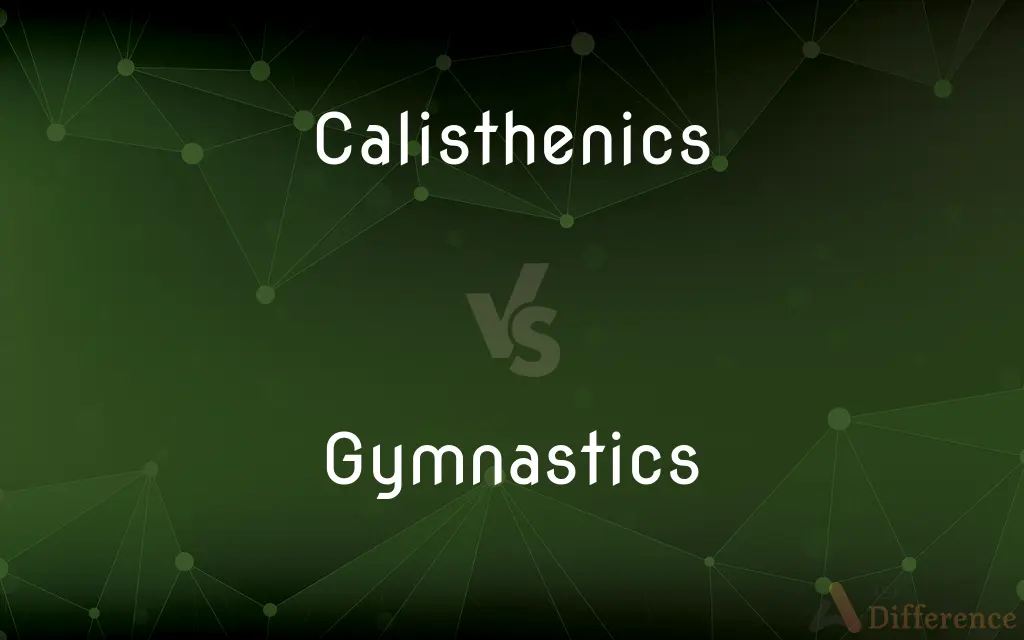Calisthenics vs. Gymnastics — What's the Difference?
By Maham Liaqat & Urooj Arif — Updated on March 29, 2024
Calisthenics focuses on rhythmic bodyweight exercises to improve fitness and strength, while gymnastics involves a wider range of activities emphasizing strength, flexibility, balance, and control.

Difference Between Calisthenics and Gymnastics
Table of Contents
ADVERTISEMENT
Key Differences
Calisthenics is centered around using one's own body weight for resistance in exercises like push-ups, pull-ups, and squats. These activities aim to improve muscular strength, endurance, and flexibility through minimal equipment usage. On the other hand, gymnastics is a competitive and recreational activity that includes floor exercises, vault, uneven bars, and balance beam for women, and floor exercises, pommel horse, still rings, vault, parallel bars, and horizontal bar for men. It not only emphasizes physical strength and flexibility but also incorporates elements of performance and artistic expression.
While calisthenics is accessible and can be practiced almost anywhere with little to no equipment, gymnastics requires specialized equipment and facilities, such as mats, beams, and bars. This makes gymnastics more structured and regulated, with formal training typically conducted in gyms under the guidance of certified coaches. Conversely, calisthenics exercises are versatile and can be adapted to suit any fitness level, making it widely popular for outdoor and home workouts.
The goals of calisthenics include improving overall physical fitness, body composition, and muscular endurance. It is often used for weight loss, muscle toning, and enhancing cardiovascular health. Gymnastics, while also improving physical fitness, places a higher emphasis on skill mastery, routine perfection, and competitive achievement. The discipline required in gymnastics extends to developing routines that are evaluated on their technical complexity, execution, and artistic impression.
Calisthenics is generally considered safer for beginners and less likely to result in injuries due to its emphasis on natural body movements and gradual progression. Gymnastics, with its complex maneuvers and requirement for precision in executing flips and turns, carries a higher risk of injury and often requires a longer period of learning and adaptation.
In terms of community and culture, calisthenics often promotes a more inclusive and community-oriented atmosphere, with outdoor parks and public spaces serving as common venues for enthusiasts to gather and practice. Gymnastics, with its competitive nature and system of formal training and grading, fosters a disciplined and achievement-oriented environment.
ADVERTISEMENT
Comparison Chart
Focus
Bodyweight exercises for fitness and strength
Strength, flexibility, balance, and control in various apparatuses
Equipment
Minimal, often none required
Specialized equipment like mats, beams, bars
Accessibility
High, can be practiced anywhere
Lower, requires specialized facilities
Goals
Physical fitness, muscle endurance, body composition
Skill mastery, routine perfection, competitive success
Risk of Injury
Generally lower
Higher due to complex maneuvers
Community and Culture
Inclusive, community-oriented
Competitive, disciplined, achievement-oriented
Training Environment
Versatile, outdoor and home workouts
Structured, in gyms with certified coaches
Compare with Definitions
Calisthenics
Focused on improving muscle tone and endurance.
Daily calisthenics routines can significantly improve your endurance.
Gymnastics
A sport involving exercises requiring balance, strength, flexibility, and control.
Gymnastics routines on the balance beam require precise control and balance.
Calisthenics
Enhances physical fitness through rhythmic movements.
Incorporating calisthenics into your routine enhances flexibility and strength.
Gymnastics
Aimed at developing routines for competition.
Gymnasts spend hours perfecting their routines for competitions.
Calisthenics
Requires minimal equipment, emphasizing bodyweight.
Calisthenics can be practiced in a park with just a pull-up bar.
Gymnastics
Requires formal training and coaching.
Aspiring gymnasts often start training at a young age in gymnastics academies.
Calisthenics
A form of exercise consisting of a variety of gross motor movements.
Push-ups and pull-ups are fundamental calisthenics exercises.
Gymnastics
Includes specialized disciplines like artistic, rhythmic, and trampoline.
Artistic gymnastics is popular for its floor routines and apparatus work.
Calisthenics
Accessible and adaptable for all fitness levels.
Beginners and athletes alike can benefit from calisthenics workouts.
Gymnastics
Utilizes apparatuses like bars, beams, and vaults.
The uneven bars demand a high level of strength and coordination from gymnasts.
Calisthenics
Calisthenics (American English) or callisthenics (British English) (/ˌkælɪsˈθɛnɪks/) is a form of strength training consisting of a variety of movements that exercise large muscle groups (gross motor movements), such as standing, grasping, pushing, etc. These exercises are often performed rhythmically and with minimal equipment, as bodyweight exercises.
Gymnastics
Gymnastics is a sport that includes physical exercises requiring balance, strength, flexibility, agility, coordination, and endurance. The movements involved in gymnastics contribute to the development of the arms, legs, shoulders, back, chest, and abdominal muscle groups.
Calisthenics
(used with a pl. verb) Gymnastic exercises designed to develop muscular tone and promote physical well-being
Sit-ups, trunk twists, and other calisthenics are demonstrated on the video.
Gymnastics
(used with a pl. verb) Physical exercises designed to develop and display strength, balance, and agility, especially those performed on or with specialized apparatus.
Calisthenics
(used with a sing. verb) The practice or art of such exercises
Calisthenics is recommended to relax the muscles before a run.
Gymnastics
(used with a sing. verb) The art or practice of such exercises.
Calisthenics
(in the plural) Gymnastic exercises under the participation of a (surface-wise) multitude of muscles and often minimal equipment (thus, usually bodyweight exercises) with a stress on stamina.
Gymnastics
Complex intellectual or artistic exercises
Mental gymnastics.
Calisthenics
(in the singular) A system of such exercises.
Gymnastics
(Informal) Feats of physical agility
Had to go through gymnastics to cross the slippery walk.
Calisthenics
The science, art, or practice of healthful exercise of the body and limbs, to promote strength, gracefulness, and general fitness; light gymnastics.
Gymnastics
A sport involving the performance of sequences of movements requiring physical strength, flexibility, and kinesthetic awareness.
Gymnastics was a significant part of the physical education curriculum.
Calisthenics
Light exercise designed to promote general fitness
Gymnastics
Complex intellectual or artistic exercises or feats of physical agility.
His mental gymnastics are legendary.
Gymnastics
Athletic or disciplinary exercises; the art of performing gymnastic exercises.
Gymnastics
Disciplinary exercises for the intellect or character.
Gymnastics
Feats demonstrating a quick mental agility; as, mental gymnastics, verbal gymnastics.
Gymnastics
A sport that involves exercises intended to display strength and balance and agility
Common Curiosities
Is calisthenics suitable for beginners?
Calisthenics is suitable for individuals at all fitness levels, including beginners, due to its adaptability and minimal risk of injury.
What type of equipment is used in gymnastics?
Gymnastics uses specialized equipment like mats, beams, bars, and vaults for training and competition.
What is calisthenics?
Calisthenics is a form of exercise focusing on using bodyweight for resistance, aiming to improve physical fitness and strength with minimal equipment.
Can gymnastics improve physical fitness?
Yes, gymnastics significantly improves physical fitness, including strength, flexibility, and cardiovascular health.
How important is coaching in gymnastics?
Coaching is crucial in gymnastics for safe practice, skill development, and competitive success.
What are the goals of gymnastics?
The goals of gymnastics include skill mastery, routine perfection, and achieving success in competitions.
Can calisthenics be done daily?
Calisthenics can be practiced daily, depending on the intensity of the workout and individual fitness goals.
How does community culture differ between calisthenics and gymnastics?
Calisthenics fosters an inclusive community culture, while gymnastics has a competitive, achievement-oriented culture.
What makes calisthenics popular?
Calisthenics is popular due to its accessibility, minimal equipment needs, and adaptability for various fitness levels.
How does gymnastics differ from calisthenics?
Gymnastics is a sport that requires specialized equipment and involves exercises for balance, strength, and flexibility, focusing on routine perfection and competitive success.
Can calisthenics be performed without any equipment?
Yes, many calisthenics exercises can be performed with no equipment, making it highly accessible.
How do the risks of injury compare between calisthenics and gymnastics?
Gymnastics carries a higher risk of injury due to its complex maneuvers, while calisthenics is generally considered safer for beginners.
Are there different types of gymnastics?
Yes, there are several types of gymnastics, including artistic, rhythmic, and trampoline gymnastics, each with specific disciplines and apparatuses.
What is the competitive aspect of gymnastics?
Gymnastics competitions involve athletes performing routines judged on technical difficulty, execution, and artistic impression.
What are the benefits of practicing gymnastics?
Benefits include improved strength, flexibility, coordination, discipline, and the opportunity for competitive achievement.
Share Your Discovery

Previous Comparison
Planning vs. Design
Next Comparison
Rebate vs. SubsidyAuthor Spotlight
Written by
Maham LiaqatCo-written by
Urooj ArifUrooj is a skilled content writer at Ask Difference, known for her exceptional ability to simplify complex topics into engaging and informative content. With a passion for research and a flair for clear, concise writing, she consistently delivers articles that resonate with our diverse audience.














































